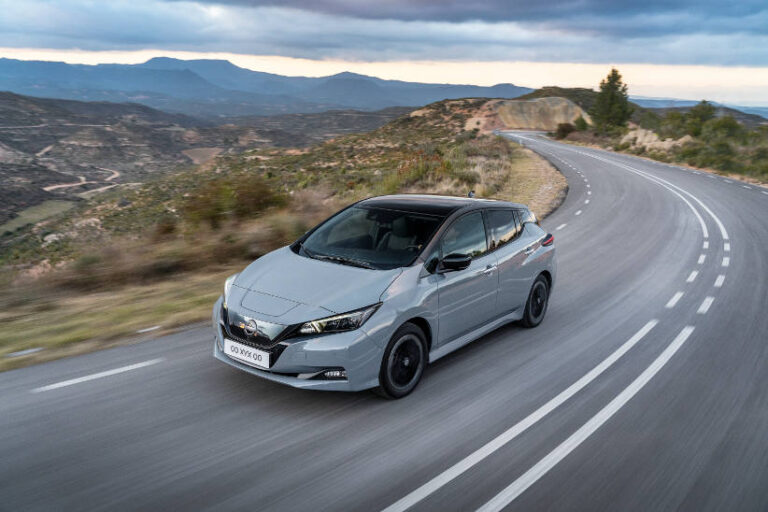A new-look LEAF is set to arrive in Australia in August, with Nissan’s pioneering EV receiving key styling and technology updates designed to make zero-emission motoring even more appealing.
The world’s first mass-market EV has been updated for the 2023 model year, with a new look and leading-edge technology, while continuing to offer a two-model line-up designed to suit differing range requirements.
The new LEAF marks the next exciting step in Nissan’s electrification journey.
“The Nissan LEAF has been inviting Australians to experience electric since the first-generation vehicle arrived here in 2012,” says Nissan Australia Managing Director, Adam Paterson.
“And with a stylish new look and more safety technology, and with the flexibility of two battery-capacity options, the switch to zero-emission motoring is now even more appealing in the new Nissan LEAF.”
“With more people now considering an EV as their next new car than ever before, electric vehicles are no longer the cars of tomorrow — they’re the cars of right now. And I’m proud to say the Nisan LEAF has been leading that charge for 10 years in Australia.”
Nissan LEAF: Dressed to impress
The new Nissan LEAF arrives with key style updates, offering wheels-up design changes that add even more appeal to the 100% EV.
Key changes include new badging, a revised front grille, and a darkened headlight finisher, all of which give the Nissan LEAF a new visual signature, whether during daylight hours or at night.
A striking new 17-inch alloy wheel design, a new rear diffuser, and sporty-looking rear spoiler and side sills complete the exterior design changes.
The updates join the LEAF’s already feature-packed exterior equipment list, including dusk-sensing LED headlights with auto levelling, LED rear lights and DRLs, heated door mirrors, and front and rear fog lights.
Nissan LEAF: The new sound of safety
One of the key benefits of EV ownership is the LEAF’s near-silent electric powertrain. But while silence in the cabin is golden, it’s important to let pedestrians and other road users know a vehicle is approaching.
The Nissan LEAF’s solution is Canto sound, a bespoke sonic identity carefully designed to be audible, but not alarming, to those outside the vehicle, even on busy city streets.
Activated at speeds of less than 30km/h, the Canto sound is composed to vary in pitch whether the vehicle is accelerating, slowing, or reversing, helping to keep other road users safe without disturbing the vehicle’s occupants.
The Nissan LEAF also features a Smart Rear-View Mirror, which pairs with a camera installed at the vehicle’s rear to deliver a crystal clear image to the mirror in the cabin. Drivers can switch between the standard mirror and the digital view at the push of button.
The new equipment joins the LEAF’s extensive existing safety functions, including Intelligent Cruise Control, front, front-side and side-curtain airbags, front and rear parking sensors, a 360-degree Around-View Monitor with Moving Object Detection, and AEB with Pedestrian Detection — all of which contribute to the Nissan LEAF’s five-star ANCAP Safety Rating.
Nissan LEAF: Two battery configurations to suit all driving needs
The Nissan LEAF will continue to be offered with two battery configurations, meaning drivers can choose the vehicle that best suits their driving style and range needs.
The Nissan LEAF continues to offer a driving range of 270 kilometres (WLTP^). The Nissan LEAF e+ offers a driving range of 385 kilometres (WLTP^). Both figures are unchanged in this update.
| Specifications | LEAF | LEAF e+ | |
| Power | kW | 110 | 160 |
| Torque | Nm | 320 | 340 |
| Driving range (WLTP)^ | kms | 270 | 385 |
| Acceleration (0-100km/h) | sec | 7.9 | 6.9 |
| Charging AC domestic socket | Hours | 21.0 | 32.0 |
| Charging AC wallbox# | Hours | 7.5 | 11.5 |
| DC quick charger (20% to 80%)~ | Hours | 1.0 | 1.5 |
*Manufacturer suggested retail prices (MSRP) are provided for media purposes only and do not include statutory charges or other on-road costs.
^ 270km (LEAF)/450km (LEAF e+) indicative range using the new WLTP test procedure for European spec model. Australian model has not been tested using WLTP test procedure. 315km (Leaf)/385km (Leaf e+) range tested to Australian NEDC ADR81/02 standard. Figures obtained after the battery was fully charged. Figures stated for the purposes of comparison amongst vehicles tested to the same technical procedures only. Actual real world driving range may vary depending on factors such as battery age and condition, driving style, use of heating/cooling, traffic conditions, weather conditions, any accessories fitted and vehicle load.
# This Home Charging time is based on, and requires use of a 32A / 6.6kW (7kW) wall box. Home Charging time will be dependent on charging conditions, including Home Charging type and condition, battery temperature and size as well as ambient temperature at point of use. Home Charging time is based on Nissan testing. Before using this product at home, consult with a licenced electrician to ensure your homes electrical system can support the use.
~ Time dependent on charging conditions, including charger type and condition, battery temperature as well as ambient temperature at point of use. Indicated rapid charging time requires use of a CHAdeMO rapid charger. The Nissan LEAF is designed to support the majority of journeys in daily life and is equipped with charging safeguards to protect the battery during repeated rapid charging sessions in a short period of time. The time taken for successive rapid charging can take longer if the battery temperature activates the battery safeguarding technology.






